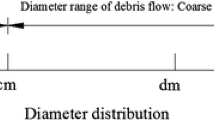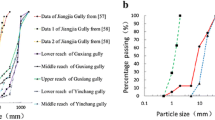Abstract
Velocities of solid phase and liquid phase in debris flow are one key problem to research on impact and abrasion mechanism of banks and control structures under action of debris flow. Debris flow was simplified as two-phase liquid composed of solid phase with the same diameter particles and liquid phase with the same mechanical features. Assume debris flow was one-dimension two-phase liquid moving to one direction, then general equations of velocities of solid phase and liquid phase were founded in two-phase theory. Methods to calculate average pressures, volume forces and surface forces of debris flow control volume were established. Specially, surface forces were ascertained using Bingham’s rheology equation of liquid phase and Bagnold’s testing results about interaction between particles of solid phase. Proportional coefficient of velocities between liquid phase and solid phase was put forward, meanwhile, divergent coefficient between theoretical velocity and real velocity of solid phase was provided too. To state succinctly before, method to calculate velocities of solid phase and liquid phase was obtained through solution to general equations. The method is suitable for both viscous debris flow and thin debris flow. Additionally, velocities every phase can be identified through analyzing deposits in-situ after occurring of debris flow. It is obvious from engineering case the result in the method is consistent to that in real-time field observation.
Similar content being viewed by others
References
Chen Hongkai, Tang Hongmei, Ma Yongtai, et al. Research and Control of Debris Flow along Highway[M] Press of the People’s Communication, Beijing, 2004, 108–121 (in Chinese).
Du Ronghuan, Li Honglian, Tang Bangxing, et al. Research on debris flow for thirty years in China[J]. Journal of Natural Disasters, 1995, 4(1):64–73 (in Chinese).
Wu Jishan, Tian Lianquan, Kang Zhicheng, et al. Debris Flow and Its Synthetical Control[M]. Science Press, Beijing, 1993, 170–180 (in Chinese).
Wu Jishan, Kang Zhicheng, Tian Lianquan, et al. Observation Reearch of Jiangjiagou Debris Flow in Yunnan Province[M]. Press of Science and Technology, Beijing, 1990, 141–164 (in Chinese).
Bagnold R A. Experimental on a gravity-free dispersion of large solid spheres in a Newtonian fluid under shear[J]. Proc Royal Soc London, Ser A, 1954, 225:49–63.
Ni Jinren, Wang Guangqian. Conceptual two-phase flow model of debris flow:I Theory[J]. ACTA Geography Sinica, 1998, 53(1):66–76 (in Chinese).
Ni Jinren, Wang Guangqian. Conceptual two-phase flow model of debris flow:II Application[J]. ACTA Geography Sinica, 1998, 53(1):77–85 (in Chinese).
Ni Jinren, Wang Guangqian. Mechanism of hyper-concentrated flow: I Theory[J]. Journal of Hydraulic Engineering, 2000, (5):22–26 (in Chinese).
Richard M Lverson. The physics of debris flow[J]. Review of Geophysics, 1997, 35(3):245–296.
Ghilardi P, Natale L and Savi F. Modeling debris flow propagation and deposition[J]. Phys Chem Earth, 2001, 26(9):651–656.
Tamotsu Takahashi. Debris flow on prismatic open channel[J]. Journal of the Hydraulics Division, Proc ASCE, 1980, 106(HY3):381–396.
Chen Chenglung. General solution for visoplastic debris flow[J]. Journal of Hydraulic Engineering, (ASCE), 1988, 114(3):259–282.
Zhou Bifan, Li Deji, Luo Defu, et al. Guiding of Prevention and Control of Debris Flow[M]. Science Press, Beijing, 1991, 65–70 (in Chinese).
Wang Jikang. Techniques of Prevention and Control of Debris Flow[M]. China Railway Press, Beijing, 1996, 61–64 (in Chinese).
Chen Hongkai, Tang Hongmei. Research on general model of highway dmage-induced by debris flow[J]. Hichway, 2003,(8):143–148 (in Chinese).
Chen Hongkai, Tang Hongmei, Ma Yongtai, A new concept of research and control of debris flow along highway[J]. Highway, 2004,(2):77–83 (in Chinese).
Chen Hongkai, Tang Hongmei, Wu Sifei. Research on countermeasures for giant debris flow disaster along highway[J]. Highway, 2004, (3):1–5 (in Chinese).
Chen Hongkai, Tang Hongmei. Theory and application of high-speed drainage structure in congtrolling debris flow[J]. The Chinese Journal of Geological Hazard and Control, 2004, 15(1):11–16 (in Chinese).
Wang Rong, Weng Qineng, Chen Hongkai. Structure and calculation to prevent highway from debris flow with strong deposition and impaction[J]. Journal of Mountain Science, 2001, 19(5):118–122 (in Chinese).
Chen Hongkai, Tang Hongmei, Wu Sifei. Research on abrasion of debris flow to high-speed drainage structure[J]. Applied Mathematics and Mechanics (English Edition), 2004, 25(11):1257–1264.
Chien Ning. Movement of Water with High Sediment[M]. Press of Tsinghua University, Beijing, 1989, 160–162 (in Chinese).
Zhang Yuanjun, Wang Huiyu, Zhang Zhengpeng, et al. Dynamics of Two-Phase Fluid[M]. Beijing Aeronautical Engineering Institute Press, Beijing, 1987, 51–111 (in Chinese).
Fei Xiangjun, Shu Anping. Movement Mechanism and Disaster Control for Debris Flow[M]. Press of Tsinghua University, Beijing, 2004:280–285 (in Chinese).
Lin Jianzhong. Fluid-Solid Two-Phase Coherent Vortex Flow and Hydrodybamic Stability[M]. Press of Tsinghua University, Beijing, 2003, 3–20 (in Chinese).
Chen Hongkai, Tang Hongmei, Ma Yongtai, et al. Research on Key Techniques of Control Structures against Impact and Abrasion of Debris Flow with Impact and Deposit[R]. Talent Fund of the Communications Ministry, 2004: 37–45 (in Chinese).
Chen Hongkai, Ma Yongtai, Tang Hongmei, et al. Research on Control Techniques of Debris Flow along Highway and Application[R]. Important Science Fund of the Highway Bureau of Sichuan Province, 2005, 60–72 (in Chinese).
Author information
Authors and Affiliations
Corresponding author
Additional information
Communicated by LIU Yu-lu
Project supported by the Talent Fund of the Ministry of Communication of China(No.95050508); the Fund of Western Communication of China(No.200332822047); the Key Science Fund of the Ministry of Communication of China(No.95060233)
Rights and permissions
About this article
Cite this article
Chen, Hk., Tang, Hm. & Chen, Yi. Research on method to calculate velocities of solid phase and liquid phase in debris flow. Appl Math Mech 27, 399–408 (2006). https://doi.org/10.1007/s10483-006-0317-z
Received:
Revised:
Issue Date:
DOI: https://doi.org/10.1007/s10483-006-0317-z




